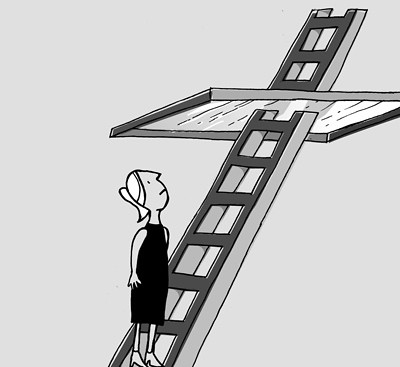The Glass Ceiling: Its Glaring Prevalence in the Workplace

flickr.com
March 25, 2022
Gender inequality has prevailed for 8000 years, evolving as the world has revolutionized, industrialized, and modernized. Despite centuries of effort to normalize women in power and equality between both genders, repercussions of gender discrimination remain prominent in today’s society in several manifestations – including the gender wage gap.
Ironically, the roots of gender inequality can be observed during the hunter-gatherer era – when men, the hunters, and women, the gatherers, were valued equally. These nomadic peoples survived strictly off of hunting, fishing, and harvesting food. If any one group was lacking, food production efficiency would diminish, leading to a loss of productivity.
However, when river-valley civilizations arose, men dominated seats of power, as they tended to be more knowledgeable about agriculture – the foundation of these budding societies. This has set a strong precedent for thousands of years and is a driving power in perpetuating gender wage disparities.
History of the gender wage gap
In the United States, the gender pay gap emerged as a political issue in the 1860s under the “Equal Pay for Equal Work” movement. During this time, women’s rights activists Susan B. Anthony and Elizabeth Cady Stanton published weekly under The Revolution – a newspaper that served as an outlet for the National Woman’s Suffrage Association (NWSA) and discussed controversial topics to catalyze women’s enfranchisement. Among these publications was a case on filling the wage gap. The newspaper’s masthead: “Men, their rights and nothing more; women, their rights and nothing less” encapsulates the fundamental purpose of the women’s suffrage movement: advancing towards equality.
The Industrial Revolution, beginning in 1820, shaped the development of a predominantly working-class America, leading, in part, to the labor struggles experienced by women. By the early-1900s, women began to pursue a dominant role in the workforce. While a quarter of women were working during this time, they were traditionally paid far less than their male counterparts.
By the mid-1900s, during World War II, women constituted 37% of the workforce; the demand for female workers increased dramatically to substitute the rising conscription rate. Women replaced men in their factory jobs and were therefore paid an equal salary due to the National War Labor Board – an agency that mediated labor dissension.
By 1945, pressures stemming from a female-dominated workforce propelled the U.S. Congress to introduce the Women’s Equal Pay Act, which would have guaranteed comparable work – equal pay for men and women working the same job. The bill, however, failed to pass, perpetuating the wage gap for yet another decade.
The 1960s, however, proved to be a more triumphant period for women. Around the same time that John F. Kennedy seized the seat of presidency, requests for a federal equal pay law stockpiled. With the support of Esther Peterson, head of the Women’s Bureau Department of Labor, and Eleanor Roosevelt, former first lady, in addition to the female representatives that facilitated the charge for a bill in Congress, the Equal Pay Act was passed. The Act mandates that incongruencies in benefits or payments cannot occur between men and women working jobs that require, “equal skill, effort, and responsibility, and which are performed under similar working conditions.” The Act also clarifies circumstances in which unequal pay may be authorized, which includes the basis of merit, seniority, workers’ quality or quantity of production, and other non-discriminatory factors. The Equal Pay Act is among the pioneers of federal laws in American history to tackle gender discrimination.
The enactment of the Equal Pay Act has blazed a trail for numerous gender equality acts in the following years. The Civil Rights Act of 1964, the Educational Amendment of 1972, the Pregnancy Discrimination Act of 1978, and the Lily Ledbetter Fair Pay Act of 2009 have each advanced efforts in eliminating the centuries-old gap.
Why does the gender wage gap exist?
In 2020, women earned 84% of what men earned. Reasons for gender disparities in salaries exist because of measurable and immeasurable factors. Measurable factors, including educational fulfillment and work experience, have reduced significantly in the past few decades as a result of advancements in women’s rights. Women are now regularly receiving education, and are thus more entitled and empowered compared to past standards. To provide perspective, the Harvard Graduate School of Education accepted its first female student in 1920, and it was only until 1945 that Harvard Medical School accepted its first woman. In the 2020-2021 academic year, Harvard has a 47.74% male population and a 52.26% female population. Evidently, great strides have been made.
Immeasurable factors, such as gender bias and motherhood, contribute to the wage discrepancy. According to Pew Research Center, roughly 42% of women in the U.S. have experienced workplace discrimination, especially in the form of a salary discrepancy.
A gender wage gap is prevalent for two reasons, both of which stem from gender bias: women are paid less than men for the same job, and women are less frequently promoted to positions of power in the workplace. Evidently, for every 100 men promoted to a seat of power in the workplace, only 86 women are promoted.
Gender bias in the workplace also manifests as the negative stigma surrounding maternal leave, as women have noted that leaving work after birth has resulted in detrimental impacts in the workplace. Among those who took parental leave from work following the birth or adoption of a child, 25% of women said negative repercussions followed when they returned, compared with 13% of men.
Stigma not only surrounds maternity leave but attacks women who are pregnant in the workplace. Dr. Yehia Nawar, a course leader at London South Bank University, surveyed 104 women – among them graduates and senior managers. According to Dr. Nawar, “All women that gave feedback about maternity said that since they became pregnant, men in their companies had treated them differently.” Women noted that microaggressions towards their pregnancy in conjunction with workplace discrimination, harassment, inequalities, stereotypes, and prejudice construct a glass ceiling that inhibits them from reaching managerial positions. Gender bias undeniably steepens the gender wage gap.
Women of color pay gap
84% is generally accepted as how much women earn per dollar earned by a man. However, this number fails to cover the whole story. Race, ethnicity, and gender intersect and amplify the disparity women of color face compared to their white female counterparts.
In 2020, Hispanic women, of any race, experienced the most prominent gender wage gap, coming in at $0.50 for every dollar a non-white Hispanic man earns. Black women earn, on average, $0.64 for every dollar. Data collected from 2015-2019 average earnings show that subgroups of Asian women vary in their average pay. Burmese and Nepali women experience the starkest wage discrepancy at $0.52 and $0.54, respectively, for every dollar earned by a white man. On the contrary, Taiwanese, Indian, and Malaysian women earn, on average, $1.21 for every dollar earned.
According to research conducted by economists Francine Blau and Lawrence Kahn, 62% of the wage incongruity between white men and women of color can fall under differences in jobs/ hours worked, and differences in the number of years of experience. However, the remaining 38% is due to discrimination – stemming from both gender and race.
The wage gap is just one fish in a sea full of weaponized mechanisms against women’s rights. While great strides towards equality have been made, great leaps have yet to come to shatter the glass divider.


